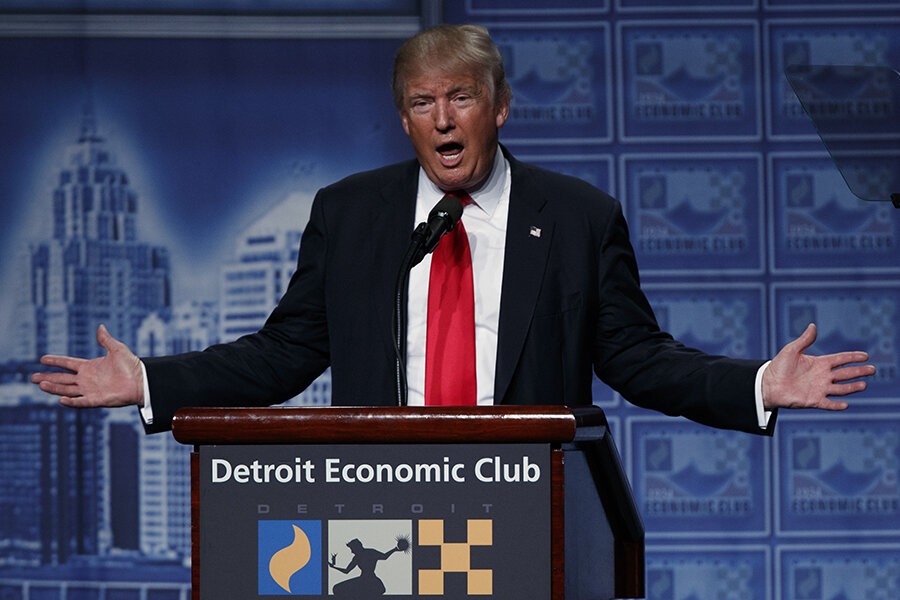Trump economic speech: first step to unifying GOP
Loading...
| Washington and Boston
In a finely tuned political speech Monday, Donald Trump reached out to mainstream Republicans on taxes and regulation, while sticking with the populist message on trade that helped him win the GOP presidential nomination.
The mix of policy prescriptions added some substance to Mr. Trump’s slogans and sought to unite Republicans bordering on panic over his sliding poll numbers. In the week after the conventions, the billionaire-turned-politician had veered into attacks on the family of a slain Muslim American soldier and resisted backing top Republicans in their reelection bids, before eventually relenting.
By Monday, in his economic speech in Detroit, a new Trump emerged – one who calmly withstood 13 interruptions by protesters and delivered a policy agenda that Republicans could rally around, including sharp digs at Democratic nominee Hillary Clinton.
“Isolation is not an option,” Trump said, in an effort to reassure mainstream Republicans who favor international trade. He called for “only great and well-crafted trade deals where we as a country for once benefit.”
Americanism, not globalism
But Trump also threw in some red meat for workers attracted to his “America first” philosophy. “Americanism, not globalism, will be our new credo,” he said.
“This was a reset and contrast speech,” says Republican strategist Ford O’Connell. “Overall, it was one of his best policy speeches, because he was able to blend conservative economic theory with a mix of Trump populism. This was about solidifying the Republican base, but also pushing back on the meme that he doesn’t have substance and is all bluster and personality.”
Trump has spoken out against the Trans-Pacific Partnership, a Pacific Rim free trade deal that has yet to be approved by Congress, as well as the North American Free Trade Agreement (NAFTA) that took effect in 1994, which many workers blame for the decline in well-paid jobs in the United States.
Key elements of Trump’s speech include:
- Adoption of the House Republican proposal for individual income tax rates. This would lower the top federal rate (currently 39.6 percent) and reduce the number of tax brackets from seven to three – 33 percent, 25 percent, and 12 percent.
- Reducing the business tax rate from 35 percent to 15 percent.
- Eliminating the estate tax.
- Allowing parents to fully deduct the average cost of child-care spending from their taxes.
- Tariffs against any countries that “cheat by unfairly subsidizing their goods.”
Trump’s tax plan would raise more revenue than his earlier proposal, which had been forecast to cost $10 trillion over a decade.
“They bumped up the income rate a little bit, but they’re still going to lose trillions of dollars,” said Jared Bernstein, an economist with the left-leaning Center on Budget and Policy Priorities and a former member of President Obama’s economic team.
“One interpretation of what we heard today is Republican-orthodoxy tax cuts on steroids with pretty punishing tariffs on imports thrown in,” adds Mr. Bernstein, former economic adviser to Vice President Joe Biden.
Bernstein gives Trump credit for stressing that he’s not an isolationist on trade. But he questions what exactly he’s proposing to renegotiate on NAFTA and how it would benefit average families. He also sees a big loophole for the wealthy in Trump’s plan for “pass-through” income. This is a way for professionals to be paid as a consultant and claim income as pass-through business income. Trump proposes a 15 percent pass-through rate – significantly lower than the top federal rate of 33 percent.
Roughly 70 percent of pass-through tax reductions accrue to the top 1 percent of taxpayers. “This is one of these tax deals that tilts towards the well off,” says Bernstein.
Looking backward?
Douglas Holtz-Eakin, president of American Action Forum and the chief economic adviser to GOP presidential nominee John McCain in 2008, calls Trump’s tax plan “a peace offering to House Republicans” but also cites outreach to labor by adopting Democratic positions on trade and infrastructure.
“We will build the next generation of roads, bridges, railways, tunnels, seaports, and airports,” Trump said, a reference to an infrastructure plan that his campaign says would be double what Mrs. Clinton is proposing.
Mr. Holtz-Eakin criticizes Trump for talking about a revival of American steel, a vision of the mid-20th century US that is not forward-looking.
“The really striking thing to me is … that there’s no talk of Uber in here, it’s steel,” says Holtz-Eakin, a former director of the Congressional Budget Office.
Donald Grimes, an economist at the University of Michigan, Ann Arbor, says that Trump made a sensible point in proposing a 10 percent tax rate on profits that US firms earn abroad but repatriate to the US. This matters more to US tech companies than automakers, he says.
But Trump’s trade protectionism is out of step with economic realities, even in Detroit, because the economy isn’t just manufacturing. The economy of Detroit, and Michigan as a whole, is steadily improving, he says.
Trump’s speech presented “a better picture of Detroit in 2010 than it is today,” says Mr. Grimes.
Trump repeatedly attacked Clinton for what he said were failed policies of the past. But Trump “is the one who wants to go back to the past with this manufacturing revival,” says Grimes.
Still, he agrees that infrastructure spending is needed. But Trump provided no details – and there are limits to what the federal government alone can do.
“This is mostly state and local government activity in the US … and most have sharply reduced their borrowings for capital projects,” says Grimes.







